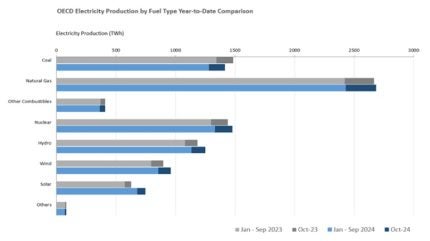
The International Energy Agency’s Monthly Electricity Statistics show that in October 2024, total net electricity generation was 857.5 TWh in the OECD, an increase of 2.1% compared to October 2023. Of this total, 396.7 TWh (46.3%) was produced from fossil fuels, 313.5 TWh (36.6%) from renewable sources and 143.8 TWh (16.8%) from nuclear power.
Electricity generation from fossil fuels in October 2024 decreased by 0.9% year-on-year (-3.4 TWh), led by a significant drop in electricity generation from coal, which fell 5.9% year-on-year to 131.1 TWh, accounting for 15.3% of the total. The largest decline was in the Americas where generation from coal decreased by 8.1% year-on-year (-4.9 TWh), driven largely by decline in the USA (-4.3 TWh y-o-y). Total generation from natural gas increased 2.7% year-on-year to 251.7 TWh (29.4% of total generation). Generation from natural gas in Europe decreased 2.5% year-on-year (-1.1 TWh), whereas the OECD Americas increased 3.2% year-on-year (+5.4 TWh) and OECD Asia Oceania also increased 7.0% year-on-year (+2.5 TWh).
Electricity generation from renewable sources increased 7.2% year-on-year (+21 TWh). The highest absolute increase came from solar generation (+11.5 TWh, +20.5% y-o-y), bringing total OECD solar generation to 67.2 TWh (7.8% of total generation). The highest absolute and percentage increase was in the OECD Americas, where solar generation increased by 36.7% year-on-year (+7.9 TWh) to 29.3 TWh, driven mainly by the United States (+6.9 TWh y-o-y). In Europe, a notable increase was seen in Türkiye, with solar electricity generation increasing by +57.0% year-on-year (+1.0 TWh), whilst in Asia Oceania, solar power in Australia increased 17.9% year-on-year (+0.8 TWh). Hydropower generation in the OECD also increased by 8.4% year-on-year (+8.9 TWh) to 114.8 TWh accounting for 13.4% of the total. Meanwhile wind generation fell by 0.7% year-on-year to 102.1 TWh (11.9% of the total). Despite this decline, wind power continues to represent 11.9% of the electricity mix.
Nuclear power generation increased by 0.4% year-on-year (+0.6 TWh). Asia Oceania and Europe registered year-on-year increases of 9.4% (+2.0 TWh) and 2.6% (+1.4 TWh), respectively. In contrast, the OECD Americas saw a decrease of 4.1% year-on-year (-2.8 TWh). This decline was driven by decreases in nuclear generation in both the US (-4.8% or -3.0 TWh y-o-y) and Canada (-6.5% or -0.5 TWh y-o-y).
There was a notable increase in the UK’s proportion of renewables generation which accounted for 51.3% of the electricity mix in October 2024, from a total of 23.4 TWh, up by 1.2% compared to the same month last year. Fossil fuels contributed 36.2%. Among fossil fuels, gas remained the primary contributor, making up 34.5% of the total electricity mix. Meanwhile coal’s share dropped to 0%, reflecting the closure of the last coal-fired power plant in autumn 2024.






